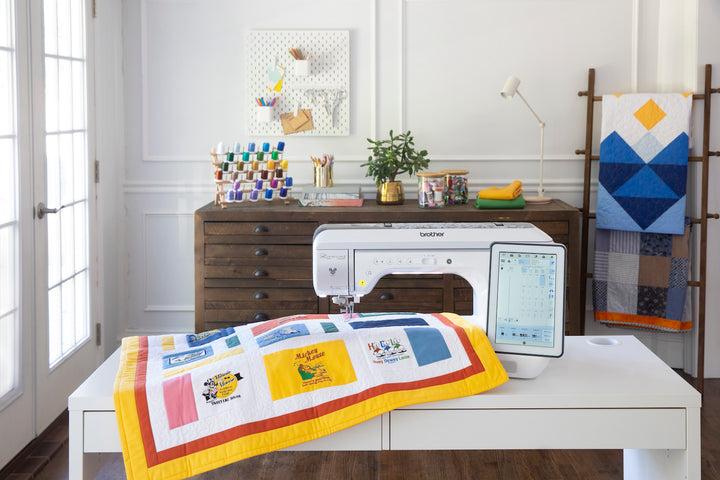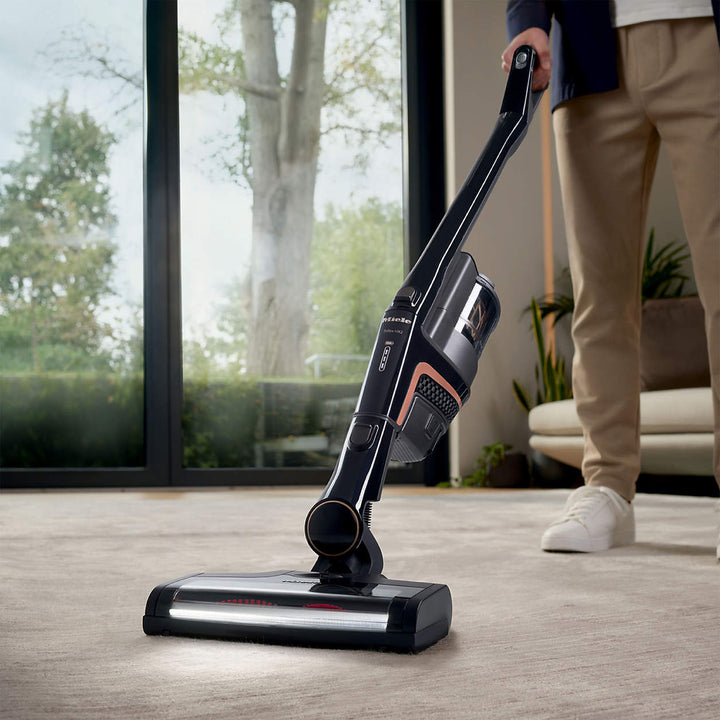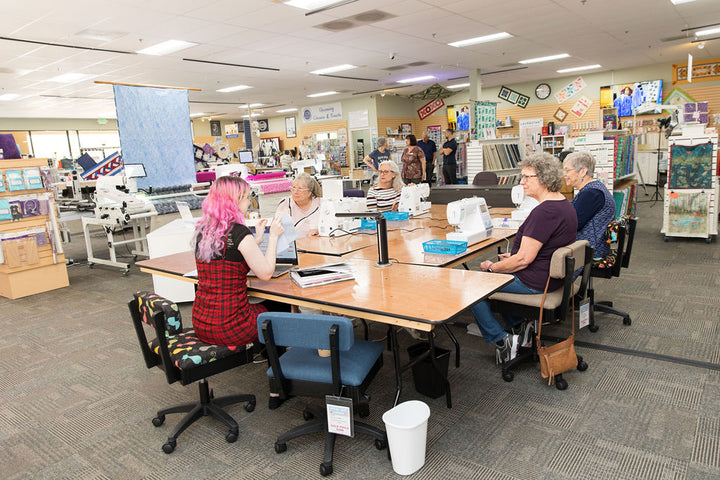Sewing machine needles are one of the most essential sewing tools out there. They’re right up at the top of the list with the machine itself, and your fabric and thread. But there are so many different types and styles and compositions of needles that it may be hard to know exactly which one will work best for your project. But have no fear — we are here to help demystify the different types of sewing machine needles!
Common Types of Sewing Machine Needles:

Universal Needles
These are the most common sewing machine needles, one of your most basic sewing supplies, and they’ll be your constant companion on your sewing journey. They’re probably the first ones you ever used, and are always handy to have in your sewing room. They have a slightly rounded tip and work well with most mid-weight woven fabrics and can also work with some knits.
Tip: These needles will certainly get you going — and may even work well for most of your projects — but if you’re not happy with your stitches, a more specialized needle may help solve your sewing problems.
[product=klasse-universal-sewing-machine-needles]
[/product]
Ball Point or Jersey Needles
A Ball Point Needle (sometimes called a Jersey Needle) has a rounded tip that nudges the fibers of your fabrics out of the way and pushes in between them instead of potentially piercing right through them. They are perfect to use with knit fabrics because they won’t won’t damage the fibers or create snags or runs in your projects.
Tip: Use them with relatively stable knit fabrics like rib knits, cotton knits, jersey, and fleece.
[product=klasse-ballpoint-sewing-machine-needles]
[/product]
Stretch Needles
Stretch Needles have a slightly blunter ball point tip. They also have a smaller eye that makes them ideal for sewing really stretchy materials like Lycra, spandex, and elastics. The higher the percentage of stretchy materials in your fabric, the more likely you are to benefit from using a Stretch Needle over a Ball Point Needle.
Tip: If you notice skipped stitches in your knit fabrics with a Ball Point Needle, you may want to try a Stretch Needle instead.
[product=klasse-strech-sewing-machine-needles]
[/product]
Microtex or Sharps Needles
Microtex Needles have a very slim point, making them perfect for lighter weight woven fabrics, as they tend to produce an even stitch without any puckers. The thin point also helps create beautiful topstitching and perfectly straight stitches for precise edge stitching.
Tip: If your fabrics aren’t playing nice with your Universal Needle, try a Microtex instead! Its slimmer point may be just what your fabric requires.
Another Tip: The sharper tips on these needles can dull faster than other kinds, so you may need to replace them more frequently.
Commonly Used Sizes: 70, 80, 90
[product=klasse-sharps-sewing-machine-needles]
[/product]
Quilting Needles
Quilting Needles have a specialized tapered point that allows it to pierce through layers of fabrics without leaving a permanent hole. They also have a deeper groove for the thread to keep it from catching on all the little batting fibers in your quilt sandwich.
Tip: Try a smaller size needle for precise piecing, and go up a size or two for quilting.
Commonly Used Sizes: 75, 80, 90
[product=klasse-sewing-machine-quilting-needles]
[/product]
Embroidery Needles
You guessed it, Embroidery Needles are specialized to work with embroidery threads while stitching out embroidery designs. They have an enlarged eye and a wider groove to accommodate thicker threads and to help protect more delicate threads by guarding them from excess friction. They will help your machine effortlessly stitch out all of those beautiful, intricate designs.
Commonly Used Sizes: 75, 80, 90
[product=klasse-embroidery-sewing-machine-needles]
[/product]
Metallic Needles
The elongated eye on Metallic Needles will be your best friend when stitching with the notoriously finicky metallic threads. The longer eye and flattened bottom edge of the eye reduce stress on the thread and help prevent it from folding over itself, all to reduce friction and minimizing shredding and breaking.
Tip: You can also use Metallic Needles with heavier weight threads, multiple threads, or even poor quality threads.
Commonly Used Sizes: 90
[product=klasse-metallic-sewing-machine-needles]
[/product]
Leather Needles
A Leather Needle is designed to literally cut through leather (or similar fabrics) to allow the thread to pass through. Keep in mind that this means that once the needle pierces the material, the hole will be permanent.
Tip: Make sure you remove your Leather Needle from the machine when finished with your leather project. You want to be careful to not use Leather Needles on knit or woven fabrics, as they may tear up the fibers and damage your project.
Commonly Used Sizes: 90
[product=klasse-leather-needles-for-sewing-machines]
[/product]
Jeans or Denim Needles
The Jeans Needle has a sharp point and a reinforced shank for pushing through layers of thick, sturdy fabrics with minimal wobbling or bending. They aren’t just for denim though — they’ll play nice with other dense fabrics like heavy twill, canvas, and heavyweight linens.
Sewing Safety Tip: Always try for a Jeans Needle when using your thickest fabrics. It’s never a good time when a needle breaks and sends shards flying right at you!
Tip: You can also use a Jeans Needle while quilting! Its extra sturdiness may help you get even smoother quilting lines through lots of layers.
[product=klasse-jeans-denim-sewing-machine-needles]
[/product]
Topstitch Needles
A Topstitch Needle has a larger eye and deeper groove for those heavier top stitching threads. It works with many different types of fabrics and can give your project a distinctive, professional-quality finish.
Tip: To help you get those perfectly straight and even top stitches, pair a Top Stitch Needle with the straight stitch needle plate on your machine.
[product=klasse-topstitch-sewing-machine-needles]
[/product]
How to Choose the Right Size Needle:
First things first: Needle sizes can be listed in both European and American sizes on some (but not all) needle packs. The American range includes Sizes 8 to 18, and the European range includes Sizes 60 - 110. If you see more than one size on your pack (usually separated by a slash), it’s listing both the American and European sizes. The smaller the number, the smaller the needle; and the larger the number, the larger the needle.
The most commonly used size is the 80/12, and that’s always a good place to start. Consider it one of your essential sewing supplies. It’s both thin enough and sturdy enough for most fabrics. A good general rule is that you don’t want to create a bigger hole in your fabric than is necessary. So after trying out your needle, you can determine whether you are happy with the look of the stitches or if you want to make some adjustments. Or maybe the needle just isn’t working well at all with your chosen fabric and thread, so it’s definitely time to make some adjustments!
Smaller size needles are generally better for thinner, lighter weight fabrics, while larger sizes work better with thick, heavyweight fabrics.
- Fabrics that may need a smaller needle: voile, tricot, chiffon, fine silk
- Fabrics that may require larger needles: upholstery fabric, denim, heavy canvas, elastic
**An Important Tip from Our Experts:
If your machine has an automatic push-of-a-button needle threader, it will NOT work with needles Size 70 or smaller or Size 100 or larger. You will almost definitely bend or damage the little hook on your threading mechanism. We recommend only using your automatic threader with needles Sizes 75 - 90. (If your machine’s needle threader uses a manual lever, you’re less likely to damage the hook, but we still wouldn’t recommend it when using a needle outside of the Size 75 - 90 range.)
Some Final Points:
How Can I Keep the Different Needles Organized?
Sometimes you need a specific type of needle for only a small part of your project. But what should you do with it later? And how to keep track of the other still-good needles for that same project? Check out the MyPad Machine Needle Organizer. It has designated spaces for the different needle types and sizes, open space for less common needles, and comes with a flower pin marker for you to note which needle is currently in your machine. It’s way better than finding that other needle you just had in your machine yesterday stuck in your ironing board several days later. Don’t ask how we know :)
[product=mypad-machine-needle-organizer]
[/product]
How Often Should I Change My Needle?
We recommend changing your needle after every 8 hours of sewing or every time you start a new project. They are meant to be replaced when worn out, and luckily they aren’t too expensive.
- There are also a few clues that can signal it’s time to change the needle:
- You hear an unusual thumping or popping sound when your needle goes through the fabric
- You see a lot of uneven or skipped stitches in instances they have not appeared before
- You start to see puckering in your fabric or notice other damage
These signs often mean that your needle has dulled or been otherwise damaged, and is now punching its way through the fabric instead of easily sliding through.
We also recommend checking your needle if your machine has jammed. This can cause the needle to bend, which will lead to lots of other problems.
If you’re just starting out and aren’t sure what to put on your Sewing Starter Kit list, we recommend the Klasse 10-Needle Pack. It contains an assortment of sizes and types of needles, so you can experience how they all work first hand.
[product=new-klasse-needle-tin-with-10-packs-of-needles]
[/product]
Hopefully you now feel confident and ready to tackle your next project, armed with the knowledge of which needle type can help you attain the best results!
Happy sewing!




